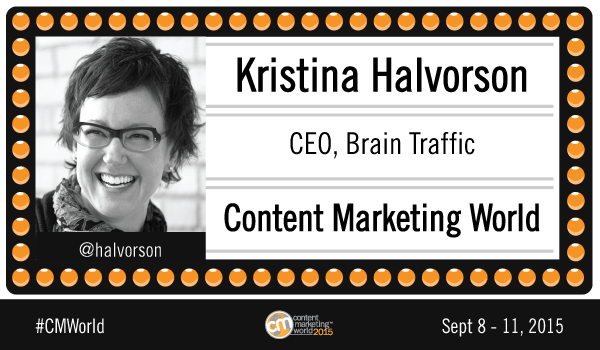When it comes to content strategy for the web, Kristina Halvorson wrote the book. Literally. Now in its second edition, Content Strategy for the Web is widely recognized as the go-to resource for content strategists all over the world. Kristina is also the CEO and Founder of Brain Traffic, and the founder of the Confab conference series.
We sat down with Kristina in advance of her upcoming keynote presentation at Content Marketing World (September 8-11) for her no-nonsense, no-holds-barred-or-prisoners-taken opinion on the current state of content marketing. Read on for her thoughts on challenges content marketers face, how to really listen to customers, and why a sensible marketing approach is better than a sexy one.
When you first founded Brain Traffic, were you planning on becoming a content strategist?
No, I started out as a freelance copywriter. The reason I picked BrainTraffic.com was there were too many ways to misspell KristinaHalvorson.com. So my only goal was to figure out how to make a living as a freelance web copywriter. My, how things have changed!
What are you passionate about in regards to content marketing and content strategy?
I’m really interested in advocating for going beyond “we’ve got to deliver valuable content to build a customer relationship.” I think we need to take several steps back and find out what the customer wants from us.
Everyone is so enthusiastic about content marketing that it can be difficult to ask the tough questions. But I think we need to be really brave about asking those questions and willing to hear what the answers are. It’s easy to get excited about tactical stuff, and start executing without asking really tough questions about what is and is not something we should be spending money on.
What are some of the top-line measurement opportunities that warrant a lot of attention? What metrics should content marketers be concerned with?
Well, first I should say my work as a content strategist is not only in marketing. We work with folks all across the board, so marketing is only one part of what we do. But no matter what industry you’re in, there is always an end user. There’s a customer, even if it’s an internal customer or an employee.
So the shared metric across the board is customer satisfaction, for me. I think we need to look at sales support as part of the equation. We should be retrieving and reviewing ongoing customer feedback to really measure our content success.
I think customer satisfaction is very difficult to measure on the very front end of customer engagement when we’re still doing awareness and discovery phases. It becomes about getting people’s attention or getting the referral. So the follow-up needs to go beyond the lip service we sometimes pay to sales support.
What does content success mean to our customers?
I think that it only falls into a couple of categories. One is post-sales support. By that I mean ongoing customer relationship support, not just “engagement.” It’s a huge area we sometimes miss as purveyors of content. There are no blanket strategies or tactical initiatives that make sense for everyone.
Like, we often hear “there is no marketing left but content marketing.” That’s a blanket statement which may not apply to every single brand. Like, if my kid has a toothache, I’m not going to Crest.com to read about what to do. But at the same time, if I’m shopping at Banana Republic, I sure do want to read an article.
What are some of the challenges facing organizations as they develop a content strategy?
There is a lot of pressure to go after the next big thing: You’ve got to be on Facebook; you’ve got to be on Twitter; you’ve got to be on Vine. People are scrambling from thing to thing. Then suddenly you have content in a lot of different places and you haven’t touched it in years.
Our company infrastructures are not set up to deal with our websites, let alone any gigantic content marketing commitment. Sometimes, people rush after new opportunities without really cleaning house first. Businesses can end up spread thin across the content marketing landscape. And who decided that was what their customers wanted?
What does a successful situation look like, where someone is approaching content with a customer in mind?
I think that a real opportunity and one that is really difficult to get is going and asking customers “what do you want?” Because oftentimes the answer is either critical of what we’ve been delivering, or it has nothing to do with what we have been marketing.
And I also think it’s easier to listen to more things we could build versus more things we could fix. A lot of the stuff we should be doing for customer support is just not that sexy. Marketers are aspirational, we want creative opportunity, we are curious individuals who want an outlet for brand expression, and to represent what we spend day-in and day-out doing. And if our customer says, “put your coupon offer on your home page” versus “your fancy Instagram account,” that’s not as sexy. But that’s the kind of feedback we need to hear to be effective.
What’s the most common advice you find yourself giving in a marketing context related to content strategy?
Talk to your users. Over and over and over. Talk to them. Don’t run a poll. Don’t do “social listening.” Because then you’re only going to hear the super unhappy or the super happy people, not the people who don’t really care, whose attention we’re trying to get. Go out and just talk to them.
I think the number one reason we don’t talk to our customers is we’re really afraid of what they’re going to say. The number one thing they might say is “I don’t care.” But that’s exactly what we need to know.
Who comes to your mind as a great example of an organization listening to customers and taking action in the way they’re creating content?
Speaking as a consumer, somebody who has delivered useful content since way before the internet is USAA. I would expect based on their bundle of services and their niche market that they would be delivering very custom, targeted, educational content. And that comes in the form of their magazine. I still get their print magazine. They’re one of the original content marketers.
Room & Board send their people on the delivery trucks into people’s homes to find out how they live, what they want, what makes them happy. They’re seeing in a real setting how people use their products.
Would you say content strategy is more important than ever, with the content production overload that exists today?
Oh yes. The role of a content strategist is to help launch a scalable, sustainable content marketing program within your organization in context of everything else you’re already committed to, keeping in mind the skill-sets you have. Or, maybe after you do an analysis, you decide to make less of a commitment because there are other priorities.
The role of a content strategist is ensuring that business goals are very clearly articulated, that user needs and what they want from your product/service have been clearly articulated. We help identify scalability, internal capability, realistically what it’s going to take to make this happen. And then helping organizations to make decisions not only about what they are going to do, but what they’re not going to do. It’s making sure the content plan is in line with what, ultimately, the end user wants and needs.
For more insights into modern content marketing strategy, read the full eBook, “The Big Picture of Content Marketing Strategy” below.
Be sure to check out the next two content marketing ebooks in our series, “Making Content Marketing the Star of Your Marketing” and “Measuring Your Content Marketing Box Office Success”.

Reserve your space at Content Marketing World (September 8-11) to hear Kristina Halvorson’s keynote, as well as insights from over 200 content marketing thought leaders.



